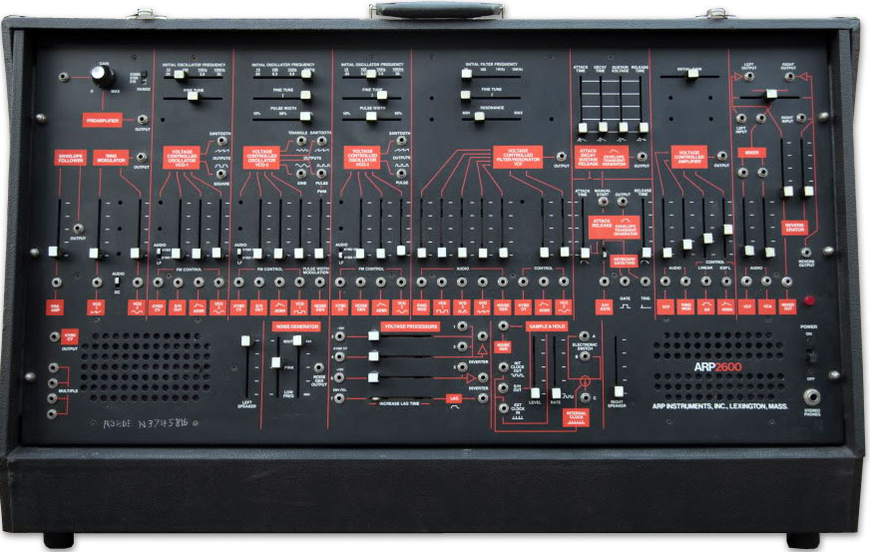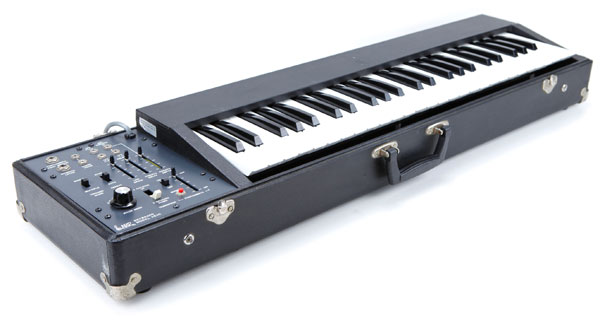|
The following 28-minute video shows a brief history of the iconic, ARP 2600 synthesizer.
In the early 70s, I bought a used ARP 2600 (with the black & white Panel). (I had a Minimoog for over a year but sold it because I wanted more out of it than it was capable of producing.) At one point, I was asked to be the original Drummer for the band "Lite As A Feather" (LAAF), around 1976. After a few months of performances, I started to bring the 2600 with me. I'd set it up just within reach of my Drums. I could then program, wind, birds, helicopter or whatever a song called for. One day, I began thinking about how I could trigger (activate) the ARP 2600 while I was playing my Drums. I then invented a very crude "Switch". It consisted of Lever Switches, which I attached to my High Tom and Floor Tom. I mounted them close enough to each drumhead so they wouldn't make contact unless that drum was struck. I connected an 1/8-inch cable from that switch to an electronic breadboard, which sat inside an aluminum box that I had created and mounted to the top of my Hi-Hat Stand. I also created an ON/OFF metal "arm" (lever) covered in clear caulking. This was connected to another switch which was inside the "box". Now I could play my Drums as normal but when I hit that "arm" with a drumstick, it would turn ON the "box" and every time I hit one of the Toms, the ARP 2600 would "fire" (activate) and a sound could be heard. Striking that "arm" again, would simply turn that circuit OFF. A few years later, I quit the band (big mistake) to get married and sold everything… my drums AND the ARP. Years later, Sylvia and I met. She was the Music Director in a church, has a Music Degree, writes music and plays keyboards. Several months after our meeting, we heard that the ARP company was closing. We immediately called them and placed an order for one of the very last ARP 2600 models ever sold by them. (It's the black panel with the orange squares.) That was the first synthesizer Sylvia and I bought together (1981). During our live performances, the 2600 was placed beside my Drumset, so I could program it for Sylvia. She had her hands full with those performances, as she played:
Here's the link to the video: https://www.youtube.com/watch?v=CaiMjwF0a64
0 Comments
The following link will take you to the Sonic State web page. There, you'll find a 55-minute video of GForce Software founder, Dave Spiers explaining the many features and sounds of Yamaha's CS80 synthesizer. It's almost a "How-To" and shows off some of the unique ways this interesting synthesizer produces sound.
Here's the link: https://sonicstate.com/news/2020/02/18/take-a-long-look-at-the-cs80-with-dave-spiers/ I discovered the following article on the Perfect Circuit website.
The article is fairly detailed and provides good explanations and illustrations on how Functions, such as AND, OR, XOR, etc. behave. Not all synthesizers offer these Functions. In Eurorack synthesizers, for instance, you have to purposely purchase a Logic Module, in order to have those capabilities. So why would you even consider buying a Module which only deals with Math Functions?… because you may want a sound to be heard or a sequence to begin when something else "starts" or "stops". That's just one, basic example of the many things which Logic Functions can handle. Check out the article below for some interesting information. Here's the link: https://www.perfectcircuit.com/signal/learning-synthesis-logic This is for those who would like to know the basic details of how sound is made in a Synthesizer and how Voltages control the many processes of that music-creation method.
The following web page contains a 47-minute video by Synthesist and Synthesizer Designer Zoe Blade.
In the video, Zoe explains how sound is created and processed, using a Eurorack Modular Synthesizer. She uses Patch Cables to interconnect the Modules during her talk. So you can see the progression of sound and voltages as she's explaining them. Here's the link to the video: https://www.gearnews.com/watch-this-unmissable-introduction-to-modular-synthesizers-by-zoe-blade/ Here's the link to her Eurorack Modular company: https://www.transistorsoundslabs.com/ The following web page contains a video interview with Electronic Music pioneer, Milton Babbit. He explains, and shows examples of:
Mr. Babbit presents several examples of various types of Electronic Music. Here's the link: https://www.synthtopia.com/content/2020/03/31/milton-babbitt-on-electronic-music-1966/ In this video, Electronic Music Artist, Mylar Melodies, explains Eurorack "Multiples" and "Switched Multiples", how they work and provides some examples of how they can be used.
Here's the link: www.youtube.com/watch?v=iIAC1Cew9r8 In this video, the Inventor of this WOW-inducing device explains what "Flash" is and how it works.
Here's the link: www.gearnews.com/flash-the-synth-built-into-a-midi-plug/ I recently watched 2 videos which provided some good information on Eurorack Synthesizers. Both were over 3-hours long. These are just 2 of a 4-Part series.
The Presenter is "DivKid", a VERY knowledgeable person in the Eurorack community. One of the other people in these Episodes is Kim Bjorn. He's the Author / Producer of 3 books:
The 3rd person in these videos is Chris Meyer, who also has a LOT of highly useful information on Eurorack Systems. In fact, he co-wrote "Patch and Tweak" with Kim and Chris also has his own YouTube Channel, called: "Learning Modular". These 4 Episodes are, basically, of Chris installing Modules into his newly-modified SEVEN ROW Eurorack case!!! That's right… Seven, horizontal rows in a monster case! As he's installing them, he explains how he installed the massive power supply as well as why he chose certain Modules over others. All 3 share their Eurorack knowledge as his case is slowly filled-in. So, the information provided is not "step-by-step" but, as you pay attention to what they're talking about, you'll find some interesting nuggets. Here's the Link to Episode 1: https://www.youtube.com/watch?v=dwR3lDa_8QE Here's the Link to Episode 2: https://www.youtube.com/watch?v=bd_JvL8YSlU There were only 2 Episodes available when I wrote this but here's the Link to where you can find the others: https://www.youtube.com/user/DivKidVideo/videos Here's the Link to Chris Meyer's "Learning Modular" YouTube Channel: https://www.youtube.com/channel/UCPJXCV7wux1v9J8Auuf2z7g/videos It looks as though Synthesizer pioneer, Alan R. Pearlman, "crossed-over" on January 5th 2019. Although more people, especially non-Musicians, will have heard of "Moog" Synthesizers, Mr. Pearlman founded the "ARP Instruments, Inc." in 1969 and contributed quite a bit to the Music industry. This is what his daughter Posted, regarding his crossing: My father passed away today after a long illness. Here's the link to the Synthtopia website, where I first learned of his crossing: www.synthtopia.com/content/2019/01/06/arp-founder-alan-r-pearlman-has-died/ Here's a link to a short, video interview with Mr. Pearlman, from 2006: www.namm.org/library/oral-history/alan-r-pearlman?fbclid=IwAR0hsbPR2buZVzHu04T5c6evuHjCnDHFxrvQTUZ2qsJNcIH5W6Q7CEFKEF8 Electronic Synthesizers helped shape Music, in every genre, since they were first invented. According to this Wikipedia article, that would be 1876: en.wikipedia.org/wiki/Synthesizer#Early_electric_instruments
Most Synthesizers have a very unique or slightly different sound. The "Moog sound" is probably the most recognizable — especially for those of us who first began listening to Music in the '60s and '70s. During those early years, the biggest companies, still known today are:
Of all the Synthesizers, up to about the 1980s, the original "minimoog Model D" was the most popular. Although I'm a "Drummer", while I was still in High School, I bought a very basic "Korg" Synthesizer. (I don't remember its name.) Hearing more and more about this "minimoog" thing, in the early '70s, I saved-up and bought one from a local Music Store ($1,495). The sounds were rich and the various combinations of sonic textures were easy to pull out of it. It was an amazing experience.
Then I heard about something called an "ARP 2600". After seeing some images and reading several articles on it, I knew I had to buy one. This thing was a monster! It had features none of the Moog Synthesizers, at that time, offered (especially on their "non-Modular" Synthesizers, like the minimoog):
Many, many Musicians have used ARP Synthesizers in their Music… and, even though the ARP company hasn't existed for decades, many Musicians continue to use those Synthesizers in their Music. Here's a link to the song "Frankenstein" by Edgar Winter. You can see him play the ARP 2600 in this video: www.youtube.com/watch?v=x1mV_5-bRPo Here's a page where you can see the different variations of the ARP 2600 over the years: www.vintagesynth.com/arp/arp.php Although ARP released several different Synthesizers over the years, my ARP 2600 could not only imitate most of their sounds but also added a bit more… that is, until I heard about the "ARP 2500"! In its day, I really wanted an ARP 2500 but Sylvia and I could never afford one. It was a big powerhouse of its time.
Here's the link to an "ARP 2500" web page, which explains some of its capabilities: www.vintagesynth.com/arp/2500.php Jimmy Page, of Progressive Rock band "Led Zeppelin", has (or had) an ARP 2500. Pete Townshend, of the Rock Band "The Who", also used an ARP 2500. You can hear that instrument's "Sequencer" Module on their song: "Baba O'Riley". It's right at the beginning. Here's a link where you can hear that song: www.youtube.com/watch?v=x2KRpRMSu4g Here's the Wikipedia page for "ARP Instruments, Inc.": en.wikipedia.org/wiki/ARP_Instruments Probably the most popular "ARP" Synthesizer was the "Odyssey". My notes here don't do enough to explain the impact Mr. Pearlman and his instruments have had on me, Sylvia and this entire world. Thank you Mr. Pearlman! Music Columnist and Synthesizer explorer, Robin Vincent, has created a video titled: "25 - Top tips for performing live with Eurorack".
A day or 2 before, he had performed with part of his Eurorack Synthesizer in a local restaurant in England, where he's from. During that performance, he realized several things which he hadn't planned for. So he created this video, in order to pass this valuable information on to others. Here's the link: www.youtube.com/watch?v=l7LFURMEs8Q |
Note:
If you'd like to "Follow", "Like" or "Comment" on our Blogs, please visit our mirrored Blogsite: Archives
November 2018
Categories
All
|
Infinity




 RSS Feed
RSS Feed
